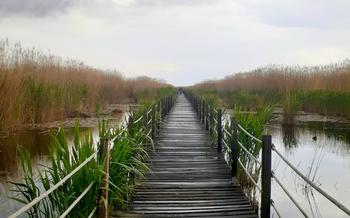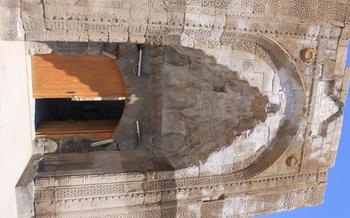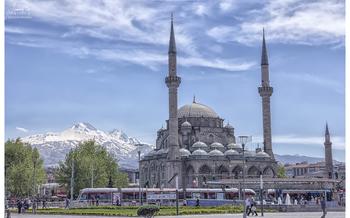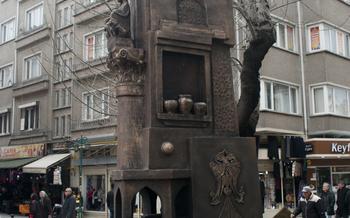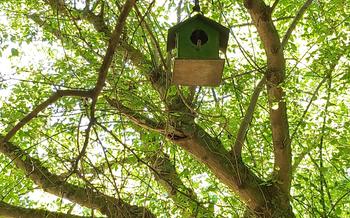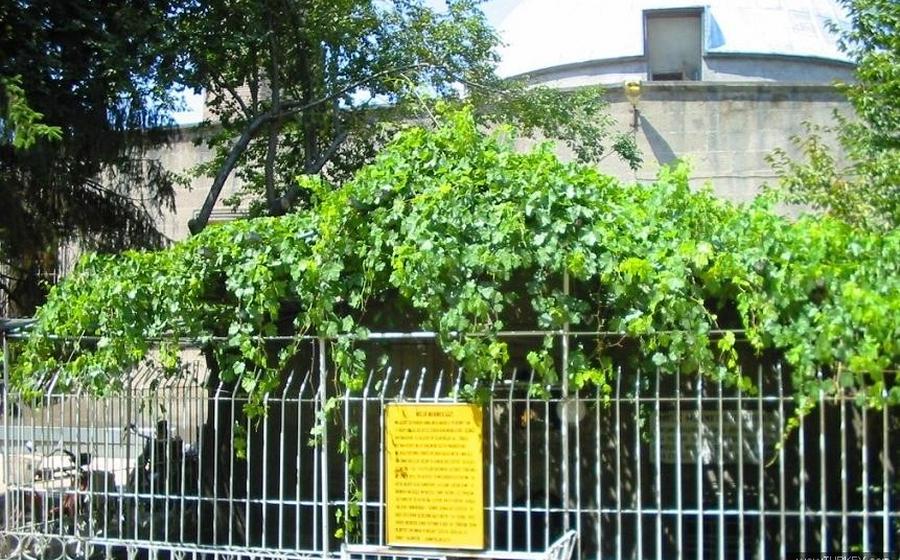
Melikgazi Tomb
- Historical Significance
- Architectural Marvel
- Sultan Melikgazi
- Location and Accessibility
- Hours of Operation and Admission
- Exploring the Tomb
- Cultural Importance
- Nearby Attractions
- Dress Code and Etiquette
- Photography and Videography
- Local Cuisine
- Souvenirs and Handicrafts
- Language and Communication
- Safety and Security
- Insider Tip: Unveiling Kayseri's Hidden Treasures
Historical Significance
The Melikgazi Tomb stands as a testament to the rich history and cultural heritage of Kayseri, Turkey. Erected in the 13th century to honor the life and achievements of Sultan Melikgazi, the founder and first ruler of the Danishmendid dynasty, this mausoleum holds immense significance in Turkish history. Melikgazi's reign marked a period of prosperity and growth for Kayseri, as he transformed the city into a thriving center of trade and education. The tomb not only serves as a reminder of his contributions but also symbolizes the deep-rooted traditions and legacy of the Turkish people.
Architectural Marvel
The Melikgazi Tomb stands as a testament to the fusion of Seljuk and Ottoman architectural styles, blending the grandeur of both eras. Its octagonal base, adorned with intricate carvings and geometric patterns, is a hallmark of Seljuk artistry. The tomb's cylindrical body, reminiscent of Ottoman architecture, is crowned by a magnificent dome that seems to touch the heavens.
The tomb's facade is adorned with exquisite tilework, featuring vibrant hues that bring the history of the structure to life. The turquoise tiles, symbolizing the vastness of the sky, contrast beautifully with the deep blue tones, representative of the boundless seas. The calligraphy adorning the tomb's exterior is a testament to the mastery of Islamic calligraphy, with verses from the Holy Quran adding spiritual significance to the site.
Inside the tomb, visitors are greeted by a serene and awe-inspiring atmosphere. The octagonal interior is divided into two sections by a beautifully crafted wooden partition. The intricately carved mihrab, indicating the direction of prayer, is a focal point of the tomb's interior, showcasing the intricate craftsmanship and attention to detail that went into its creation.
The tomb's architectural design is not just aesthetically pleasing but also symbolic. The octagonal shape, with its eight sides, represents the eight gates of Paradise, while the dome symbolizes the heavens. The tomb's location atop a hill further emphasizes its connection to the divine, as it seems to reach towards the sky, connecting the earthly realm with the celestial above.
Sultan Melikgazi
Sultan Melikgazi, the illustrious founder of Kayseri, was a man of remarkable character and achievement. His vision and determination laid the foundation for the city's growth and prosperity, transforming it into a thriving center of trade and culture. As the first ruler of the Danishmendid dynasty, Melikgazi played a pivotal role in shaping the region's history.
His military prowess was matched by his administrative skills. Melikgazi's reign was marked by the establishment of justice, security, and economic development. He patronized the arts and sciences, attracting scholars and intellectuals to his court. Under his rule, Kayseri became a beacon of knowledge and enlightenment.
Sultan Melikgazi's legacy extends far beyond his lifetime. He is revered as a symbol of unity and strength, a leader who brought peace and prosperity to the region. His contributions to the development of Kayseri are still visible today, making him an enduring figure in Turkish history and culture.
The Melikgazi Tomb serves as a testament to his greatness, a place of pilgrimage for those seeking inspiration and guidance. His name and deeds continue to be celebrated, ensuring that the memory of this extraordinary ruler lives on for generations to come.
Location and Accessibility
The Melikgazi Tomb is situated in the heart of Kayseri, a city renowned for its rich history and cultural heritage. It lies within the vicinity of the city center, making it effortlessly accessible for visitors.
To reach the tomb, one can opt for various modes of public transportation, ensuring a convenient and hassle-free journey. Numerous bus lines traverse the city, with designated stops within walking distance of the tomb. For those seeking a more personalized experience, taxis are readily available and offer a direct route to the site.
For those arriving by car, ample parking facilities are available in the vicinity of the tomb. Designated parking areas provide a safe and secure space for visitors to leave their vehicles while they delve into the historical significance of the site.
Hours of Operation and Admission
The Melikgazi Tomb is open to visitors every day of the week, from 8:00 AM to 6:00 PM. It is one of the few historical sites in Kayseri that observes consistent hours throughout the year, making it convenient for travelers to plan their visit.
Admission to the tomb is free of charge, allowing everyone to explore this architectural masterpiece without any financial barriers. However, it is essential to respect the significance of the site by maintaining proper decorum and adhering to any regulations displayed within the premises.
For group visits or guided tours, it is advisable to contact the Kayseri Municipality Tourism Office in advance. They can help arrange specialized tours with knowledgeable guides who can provide insights into the history, architecture, and cultural significance of the Melikgazi Tomb. These guided tours offer a deeper understanding and appreciation of this remarkable monument.
Exploring the Tomb
The Melikgazi Tomb boasts a captivating layout, inviting visitors to delve into its rich history and symbolism. As you step inside, you'll notice the tomb's cruciform plan, a unique feature that sets it apart from other Seljuk tombs. The central dome, supported by four massive pillars, creates a sense of grandeur and awe, while the intricate tilework adorning the walls and ceiling adds a touch of elegance and artistry.
Take your time to admire the exquisite carvings and inscriptions that adorn the tomb's interior. These decorative elements tell stories of Melikgazi's life and achievements, as well as verses from the Quran, creating a sacred and spiritual atmosphere. Look out for the mihrab, a beautifully crafted niche indicating the direction of Mecca, which holds religious significance for Muslim visitors.
To enhance your understanding of the tomb's history and symbolism, consider renting an audio guide or hiring a local guide who can provide insightful commentary and anecdotes. These guides can bring the tomb to life, sharing stories about Melikgazi's reign, the construction of the tomb, and the cultural significance it holds for the people of Kayseri.
Cultural Importance
The Melikgazi Tomb holds immense cultural significance in Turkey. It is a revered symbol of the Seljuk dynasty, representing their architectural prowess and the blend of Islamic and Anatolian traditions. The tomb's intricate carvings, calligraphy, and geometric patterns embody the artistic and cultural heritage of the region.
Beyond its architectural significance, the tomb holds deep religious and spiritual meaning for the people of Kayseri. Sultan Melikgazi was a pious and respected figure, and his tomb is considered a sacred site. Many visitors come to the tomb to pay their respects, offer prayers, and seek blessings.
Local traditions and customs are closely associated with the Melikgazi Tomb. During special religious occasions, such as the Mevlid-i Nabi, the tomb becomes a center of festivities and celebrations. Locals gather to recite prayers, perform religious rituals, and distribute food and sweets to honor the memory of Sultan Melikgazi.
Nearby Attractions
The Melikgazi Tomb is a prominent landmark in Kayseri, and its vicinity offers a wealth of other captivating historical and cultural attractions. Just a short distance away, visitors can explore the stunning Hunat Hatun Mosque, renowned for its intricate Seljuk architecture and vibrant blue tiles. The Kayseri Castle, a magnificent fortress dating back to Byzantine times, stands as a testament to the city's rich history.
For those seeking a deeper dive into the region's past, the Kayseri Archaeological Museum houses an impressive collection of artifacts, including ancient pottery, sculptures, and coins. The Döner Kümbet, an iconic Seljuk mausoleum, is another architectural gem worth visiting.
Combining these nearby attractions with a visit to the Melikgazi Tomb creates a comprehensive and enriching cultural experience. Visitors can immerse themselves in the history and heritage of Kayseri, exploring the diverse architectural styles and significant landmarks that have shaped this vibrant city.
Dress Code and Etiquette
When visiting the Melikgazi Tomb, it is essential to respect local customs and traditions, particularly regarding dress code and etiquette. Turkey is a predominantly Muslim country, and conservative attire is generally preferred. It is advisable for both men and women to dress modestly. Men should avoid wearing shorts, while women should cover their shoulders and knees. Revealing or tight-fitting clothing is not considered appropriate. When entering the tomb, visitors should remove their shoes as a sign of respect. It is customary to be quiet and maintain a respectful demeanor inside the tomb. Photography and videography are allowed, but visitors should be mindful of not disturbing other visitors or taking photos of individuals without their consent.
Photography and Videography
Guidelines for taking photos and videos inside the tomb
- Photography and videography are generally allowed inside the Melikgazi Tomb, but visitors should be respectful of the religious and cultural significance of the site.
- Flash photography and tripods are not permitted inside the tomb, as they can damage the delicate interior and disturb other visitors.
- Visitors should avoid taking photos or videos of people praying or engaged in religious activities.
Restrictions or limitations on photography or videography
- Commercial photography or videography for professional purposes is not allowed without prior permission from the authorities.
- Visitors may be asked to stop taking photos or videos if they are causing a disturbance or if their actions are deemed disrespectful.
Tips for capturing the best shots of the tomb's architecture
- Use natural light whenever possible to capture the intricate details of the tomb's architecture.
- Experiment with different angles and perspectives to create unique and interesting shots.
- Consider using a wide-angle lens to capture the full grandeur of the tomb's interior.
Local Cuisine
When visiting Kayseri, don't miss the chance to savor the local cuisine, which boasts a rich blend of flavors and culinary traditions. Just a stone's throw from the Melikgazi Tomb, you'll find an array of restaurants and eateries that offer a taste of the region's delights.
For a truly authentic experience, try mantı, a type of Turkish ravioli served with garlic yogurt sauce and topped with paprika butter. Another local favorite is keşkek, a hearty dish made from wheat, meat, and chickpeas, slow-cooked to perfection.
If you have a sweet tooth, indulge in güllaç, a delicate dessert made from layers of filo pastry soaked in milk and topped with pomegranate seeds and nuts. And for a refreshing drink, sip on ayran, a traditional yogurt-based beverage that perfectly complements the local cuisine.
Whether you're looking for a quick bite or a leisurely dining experience, Kayseri has something to satisfy every palate. Don't leave without trying these culinary gems that will leave you wanting more.
Souvenirs and Handicrafts
Local Handicrafts or Souvenirs to Buy as Mementos:
- Kayseri is renowned for its vibrant handicrafts and unique souvenirs that reflect the city's rich history and culture. Visitors can find an array of handmade items, including intricate carpets, colorful pottery, hand-painted ceramics, and traditional Turkish lamps.
- The Melikgazi Tomb area is surrounded by shops and bazaars where visitors can browse and purchase these local treasures.
Shops or Bazaars Near the Tomb Where Visitors Can Find Souvenirs:
- The narrow streets surrounding the Melikgazi Tomb are lined with charming shops and bazaars, each showcasing a diverse collection of souvenirs and handicrafts.
- Visitors can find everything from traditional Turkish coffee pots and ornate jewelry to handmade textiles and souvenirs featuring motifs inspired by the tomb's architecture.
- Bargaining is a common practice in these bazaars, so visitors can engage with the friendly shopkeepers and try their skills at negotiating for the best prices.
Tips for Bargaining and Getting the Best Deals:
- When shopping for souvenirs in Kayseri, it's customary to engage in friendly bargaining with the shopkeepers.
- Visitors can start by offering a lower price than the initial asking price and gradually increase their offer until reaching a mutually agreeable price.
- It's essential to remain polite and respectful during the bargaining process, as the shopkeepers appreciate good manners and a friendly approach.
Language and Communication
In Kayseri, the primary language spoken is Turkish. However, due to the influx of tourists, many locals, particularly those working in the tourism sector, have a basic understanding of English. If you encounter language difficulties, most hotels and tourist information centers have English-speaking staff who can assist you.
To communicate effectively with locals, it's helpful to learn a few basic Turkish phrases, such as "merhaba" (hello), "teşekkür ederim" (thank you), and "lütfen" (please). Body language and gestures can also be useful for conveying messages.
If you prefer a more immersive experience, consider hiring a local guide. Guided tours are available in various languages, including English, and can provide insights into the history, culture, and traditions of Kayseri.
Safety and Security
Kayseri is generally a safe city for tourists, but as with any travel destination, it's essential to be vigilant and aware of your surroundings. The area around the Melikgazi Tomb is well-lit and patrolled, making it relatively safe to visit during the day. However, it's advisable to avoid walking alone at night, especially in poorly lit areas. When visiting the tomb, be cautious of pickpockets and petty theft, which can occur in crowded tourist areas. Keep your valuables secure and avoid carrying large amounts of cash. In case of an emergency, dial "112" to reach the police, ambulance, or fire department. English-speaking operators are available 24/
Insider Tip: Unveiling Kayseri's Hidden Treasures
Beyond the majestic Melikgazi Tomb, Kayseri unveils a treasure trove of hidden gems waiting to be discovered. For those seeking a unique perspective of the city, venture off the beaten path to uncover secret spots that offer breathtaking views. Climb to the top of the ancient Kayseri Castle, where panoramic vistas of the city and the surrounding Erciyes Mountain await. Explore the labyrinthine alleys of the old town, where history whispers from every corner, and stumble upon hidden courtyards adorned with vibrant street art. As the sun sets, immerse yourself in the enchanting atmosphere of the "Kapali Çarşi" (Covered Bazaar), where the air fills with the scent of spices and the hum of local conversations. Embrace the vibrant energy of Kayseri and let its hidden treasures captivate your senses, making your journey truly unforgettable.

